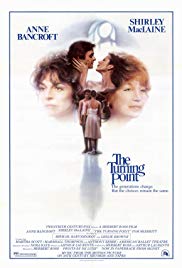A detailed description of the plot of the film is necessary for parents and teachers to evaluate its suitability as a teaching tool.
As the film begins, we learn that seventeen years earlier, Deedee (Shirley MacLaine), was a rising star with a major New York City dance company. When she became pregnant by one of the male dancers, they married, moved to Oklahoma, started a dance school, and had three children. The marriage is a happy one. Deedee’s friend and rival, Emma (Anne Bancroft) stayed in New York and became the prima ballerina of the company.
The action of the movie begins when the dance company, with Emma still its reigning ballerina, visits the town in which Deedee and her family live. Deedee has a party for the company, seeing Emma again for the first time in years. Deedee’s sixteen year old daughter, Emilia, is allowed to take dance classes with the company. She dances so well that she is offered admission to the company ballet school. Deedee’s son, about age 12, is having trouble choosing between ballet and baseball. At her husband’s suggestion, Deedee takes Emilia and the boy to New York City to spend a summer taking intensive dance classes.
They stay with Alexandra Danilova, the great prima ballerina, essentially playing herself. Now elderly, she coaches ballerinas and takes in boarders to make ends meet. In the company ballet school Emilia shines and she is given a principal role in a summer performance.
Emilia, Deedee and Emma each have a major crisis during the course of the summer. Deedee is doubting her decision to abandon her career as a ballerina and concentrate on her family. Treated as just another parent at the company ballet school, she feels very much on the outside. She meets and has an affair with an old flame.
Emilia meets Yuri, a famous dancer from Russia. (Yuri is Mikhail Baryshnikov playing himself; we are shown scenes of the company, including Baryshnikov, in class.) Yuri soon romances Emilia. They have a short affair which ends when Emilia sees Yuri and another ballerina kissing in a dressing room. Emilia also discovers that her mother is staying out all night. (How could she miss it? Mother and daughter sleep in the same room at Danilova’s.) Emilia, naturally, is upset by her mother’s infidelity as well as Yuri’s shallowness.
Emma is in crisis because younger dancers are being selected for the ballets that in the past had been her domain. Her lover, who in years past had offered to divorce his wife and marry her, gets cold feet when she hints that she might finally be receptive to a proposal.
All the frustration and the years of pent-up jealousy between Deedee and Emma culminate in a comic fight in cocktail dresses outside of Lincoln Center. Deedee’s husband comes to town and she realizes how lucky she is to have him. Emma begins to focus on being a mentor to Emilia. Everyone lives happily enough ever after, knowing that if you are going to give your life to performance and artistry, there will be great sacrifices.


